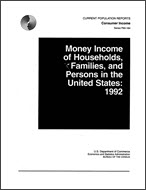Money Income of Households, Families, and Persons in the United States: 1992
Money Income of Households, Families, and Persons in the United States: 1992
Note
Estimates of 1991 income data shown in tables A, 1, 13, and 24 of this report may differ slightly from those shown in the Consumer Income report, Series P-60, No. 180, entitled, Money Income of Households, Families, and Persons in the United States: 1991. The data shown in the 1991 report were based on a computer tape file which omitted the supplement weights for nine person records. This omission was identified in time for the release of the March 1992 Annual Demographic File and is noted in User Note 2 of the file's technical documentation. The omission of the supplement weights, however, was not identified until after the release of the P-60, No. 180 report. Since the omission of the weights from the nine person records did not significantly affect income estimates, no further revisions were made to the historical data sets.
Information on income characteristics of the population by farm and nonfarm residence will no longer be included in the Consumer Income reports based on the Current Population Survey (CPS). As of January 1993, the control card item identifying farm and nonfarm residence was no longer asked in the CPS because of discontinued funding by the Department of Agriculture.
The estimates for March 1991, 1992, and 1993 in this report are inflated to national population controls by age, race, sex, and Hispanic origin. The population controls are based on results of the 1980 census carried forward to 1991, 1992, and 1993. The estimates in this report, therefore, may differ from estimates that would have been obtained using 1990 census results brought forward to the survey date. The Bureau of Labor Statistics, the sponsor of the CPS, made the decision not to use the 1990 census results as population controls for the 1993 CPS, however, population controls incorporating 1990 census results are planned to be used for survey estimation in 1994.
Introduction
This report presents data on the income of households, families, and persons in the United States for the calendar year 1992. These data were compiled from information collected in the March 1993 Current Population Survey (CPS) conducted by the Bureau of the Census. The survey consisted of approximately 60,000 households nationwide.
All demographic surveys, including the CPS, suffer from undercoverage of the population. This undercoverage results from missed housing units and missed persons within sample households. Compared to the level of the 1980 Decennial Census, overall CPS undercoverage is about 7 percent. Undercoverage varies with age, sex, and race. For some groups, such as 20 to 24 year old Black males, the undercoverage is as high as about 35 percent. The weighting procedures used by the Census Bureau partially correct for the bias due to undercoverage. However, its final impact on estimates is unknown. For details, see appendix D.
The official income estimates in this report are based solely on money income before taxes and do not include the value of noncash benefits such as food stamps, Medicare, Medicaid, public housing, and employer-provided fringe benefits. For a discussion of the effects of taxes and noncash benefits on income in 1992, see Current Population Reports, Series P60-186RD, Measuring the Effect of Benefits and Taxes on Income and Poverty: 1992.
This report begins with a section discussing household income, highlighting year-to-year comparisons by region, age of householder, type of household, type of residence, race and Hispanic origin, and tenure. This is followed by sections discussing changes in family income by family composition, race and Hispanic origin, type of residence, and number of earners in the family. Discussion of the income of year-round, full-time workers, per capita income, income inequality, State income data, and health insurance coverage of persons follows the family section.
The CPS is a cross-sectional survey which can provide a series of snapshots of the socioeconomic conditions that exist at different fixed points in time. To demonstrate the extent to which individuals and population subgroups experience year-to-year changes in economic well-being, information from the Survey of Income and Program Participation (SIPP), an ongoing longitudinal survey, is also included in this report. See the section entitled "Distribution of Income-to-Poverty Ratios.''
Others in Series
Publication
Publication
Publication






